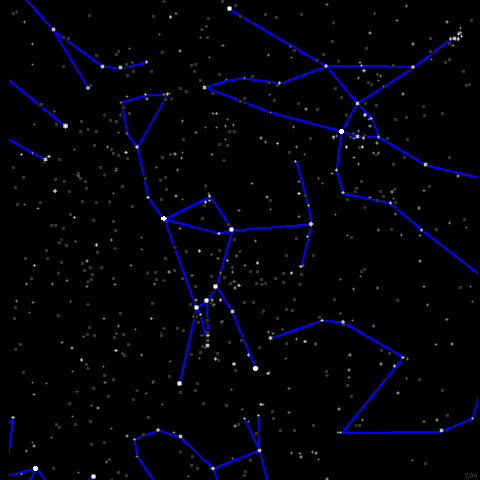THE SKY
The sky was fascinating to the Greeks.
They thought that the stars were awesome.
One myth about the sky is one called Orion.
The story is below.

Orion was a strong and fierce warrior. Orion was the son of Poseidon the sea god and Euryale, daughter of King Minos of Crete. Poseidon gave Orion the power to walk on water.
Homer in the Odyssey describes Orion as a giant hunter, armed with an unbreakable club of solid bronze.
In the sky, the hunter’s dogs (the constellations Canis Major and Canis Minor) follow at his heels, in pursuit of the hare (the constellation Lepus).
On the island of Chios, Orion wooed Merope, daughter of King
Oenopion, one night while when he drank too much
wine he tried to attack her.
In punishment, Oenopion took out Orion’s eyes and banished him from the island. Orion headed north to the island of Lemnos where Hephaestus had his forge. Hephaestus was sorry for the blind Orion and offered one of his assistants, Cedalion, to be his eyes and help him see where he was going.

Orion carried Cedalion on his shoulders, and headed
east towards the sunrise, which an oracle had told him would restore his sight.
As the Sun’s healing rays fell on his sightless eyes at dawn, Orion’s vision
was miraculously restored.
Orion is linked in a stellar myth with the Pleiades star cluster in Taurus. The Pleiades were seven sisters, daughters of Atlas and Pleione.
As the story is usually told,
But according to Hyginus, it was actually their
mother Pleione he was after.
Zeus snatched the group up and placed them among
the stars.
CREDIT
Ma-Nogoy (ICSA)
Picture by Michelet B (Own work) [GFDL (http://www.gnu.org/copyleft/fdl.html), CC-BY-SA-3.0 (http://creativecommons.org/licenses/by-sa/3.0/), CC-BY-SA-2.5-2.0-1.0 (http://creativecommons.org/licenses/by-sa/2.5-2.0-1.0), GFDL (http://www.gnu.org/copyleft/fdl.html), CC-BY-SA-3.0 (http://creativecommons.org/licenses/by-sa/3.0/) or CC-BY-SA-2.5-2.0-1.0 (http://creativecommons.org/licenses/by-sa/2.5-2.0-1.0)], via Wikimedia Commons